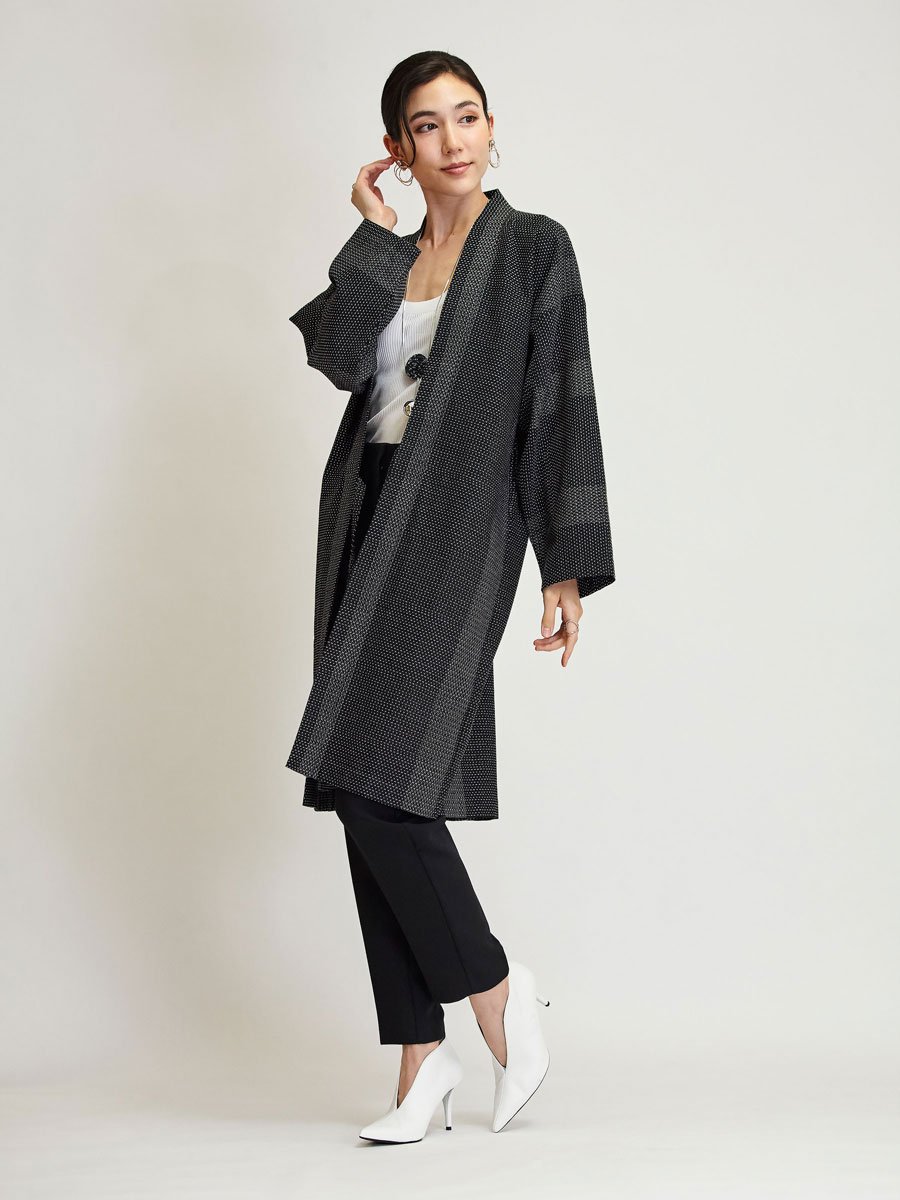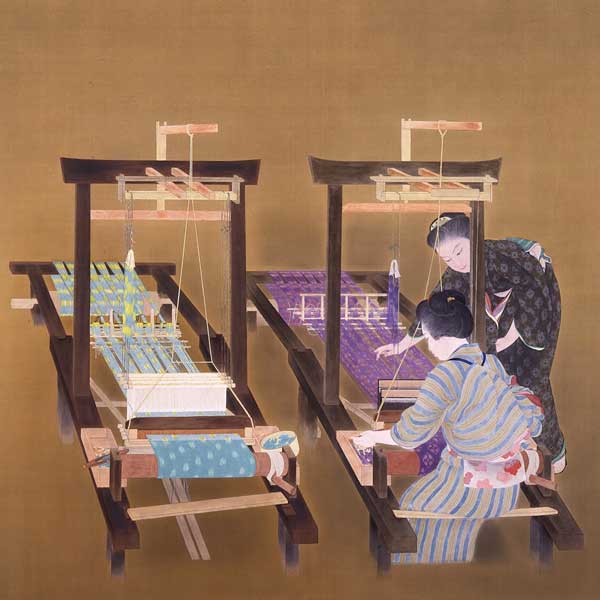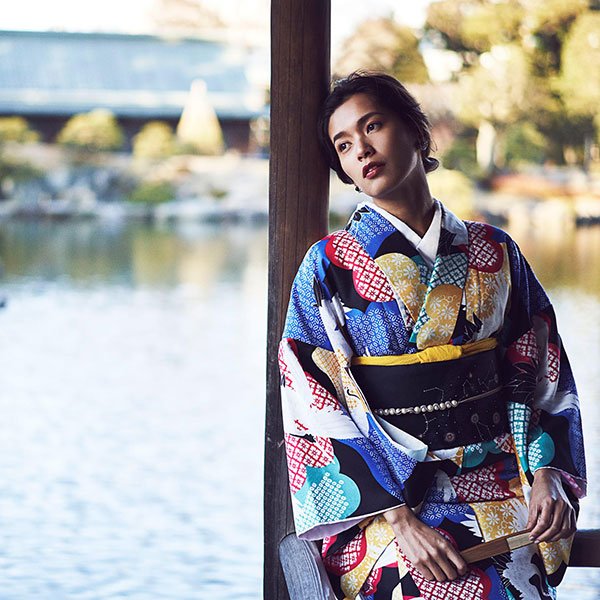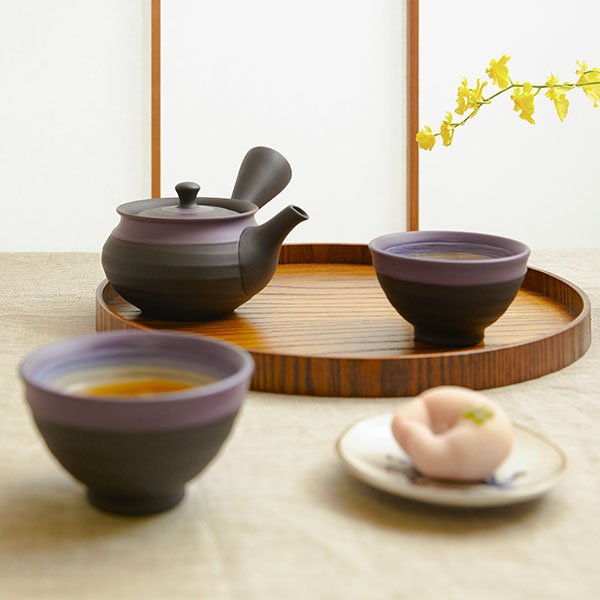What are Haori? 20 Things to Know About Japanese Jackets
by Cath Lealand & Jessica Esa | LIFESTYLE
Vintage Autumn Haori Jacket, available at Japan Objects Store
Luxurious haori jackets have been worn in Japan for centuries, with a fascinating history behind them and a legacy that has allowed them to remain an important part of Japanese culture and customs to this day. Often and traditionally paired with a kimono, or hakata, they also look fabulous as part of a contemporary style, and haori pair well with a shirt and jeans. They are perfect for adding a touch of glamour or a splash of color to an everyday outfit and can easily replace your jacket on warmer days for a bespoke look that’s tipped with traditional Japanese fashion. If you want to learn more about this fascinating garment, and also find out how to choose one that is right for you then enjoy this complete guide to Japanese haori jackets.
1. What is a Haori?
2. What's the History of Haori?
3. How are Haori Made?
4. Where are Haori Made?
5. What are Haori Made Of?
6. Are There any Special Designs for Haori?
7. How to Fasten Haori?
8. What Types of Haori Jackets are There?
9. What are the Differences between Vintage and Modern Haori?
10. When Can You Wear Haori?
11. What Season Can You Wear Haori?
12. What are the Differences Between Men’s and Women’s Haori?
13. Where to Buy Haori Jackets?
14. What to Look Out for When You’re Buying a Haori?
15. What Size Haori Should I Buy?
16. How Should I Display/Store my Haori?
17. How Do I Clean my Haori Jacket?
18. Do I Have to Wear a Kimono with a Haori Jacket?
19. What’s the Difference Between Haori and Hanten?
20. What’s the Difference Between Haori and Happi?
1. What is a Haori?
Forest Shibori Haori Jacket available at Japan Objects Store
Simply put, a haori (羽織) is a Japanese traditional jacket with a loose fit. The word haori is derived from the word haoru, meaning to put on a gown, coat or jacket, and can be considered a clothing item along the lines of a jacket, or cardigan in Western clothing. The haori is used to protect against the cold, for ceremonial purposes, and, particularly in more recent times, for fashion.
2. What’s the History of Haori?
Haori by Tatsumi Shimura, 1980s
The origin of the haori is not completely certain, but it is believed to have originated in the Sengoku period (around the 16th century), worn by warriors over their battle armor to protect against the cold weather. Later they became popularised among women by geisha who would wear them over their kimono as a fashionable item. Since they had been traditionally been worn by men up until this point, they were seen as particularly stylish and for women to wear. From the 18th century, haori started to become commonplace enough that they would be decorated with family crests and came to be seen at traditional ceremonies.
Men’s Haori Jacket, 20th Century, the Met Museum
From the Taisho era (1912-1926) to the prewar period of the Showa era (1926-1989), women began to attend social events such as kabuki, tea ceremonies, reunions, and social gatherings, and the haori, which had been men's formal wear, became a "going out wear" for women as well. This shift from an exclusively male samurai item to attire for all Japanese people means that the haori has a long legacy in Japanese culture and is a perfect piece for a classic wardrobe.
3. How are Haori Made?
Weaving Kurume Cotton
The haori design is a similar shape to a kimono, with a long torso section and long, rectangular sleeves, attached with a straight seam. The haori features a narrower collar than the kimono, and the torso is narrower, with no overlapping front panels, meaning they are much simpler to wear than kimono and require no decorative belts. Traditionally, a single piece of fabric was used to create each haori. Throughout the 20th century the design evolved with a shorter sleeve length and body. In their modern incarnation, a haori is a lightweight jacket that closes at the front with a simple tie, and can be worn with any outfit.
4. Where are Haori Made?
Vintage Silk Men’s Haori Jacket, available at Japan Objects Store
As a staple item of any quality kimono store, haori are made throughout Japan. Of course, each region (and each kimono maker) has their particular fabric design or pattern. The region most famous for contemporary cotton haori jackets is the southern city of Kurume, known for their Kurume kasuri cotton. You can find out more in 12 Things to Know About Kurume Cotton.
5. What are Haori Made Of?
Miyako Indigo Haori Jacket, available at Japan Objects Store
Like kimono, haori are made from various types of hand-decorated fabrics. In the past, the most common was silk (All You Need to Know About Japanese Silk). More popular these days is high-quality cotton, which can be woven with a variety of traditional motifs, and is easier to care for than silk! Haori can be found in a wide range of fabrics, including gauze, lace, or even heavier fabrics like wool, or synthetic fabrics such as polyester and rayon. Whatever the fabric, haori capture the elegance of Japanese design and culture.
6. Are There any Special Designs for Haori?
Golden Temple Men’s Haori Jacket, available at Japan Objects Store
Men’s haori, which generally have been used in formal situations, are found in plain colours (such as black or navy), but often feature beautiful hand-painted artworks on the lining, known as gakuura (額裏).
Golden Temple Men’s Haori Jacket, available at Japan Objects Store
As ostentatious displays of wealth were frowned upon and viewed as disrespectful during the Edo period, many wealthy Japanese men of the past would hide these intricate designs on the inside back panel of their haori. The variety of artworks are vast, ranging from moody landscapes to scenes of wild samurai battles.
Women’s haori, on the other hand, are worn in a variety of situations. This means that there are a huge choice of colours, patterns and designs available.
MIzumari Haori Jacket, available at Japan Objects Store
This cotton haori is made with Kurume kasuri cotton. The design, known as mizumari is unique to the Kurume region, and is renowned for its meticulous double weave with intricate geometric motif.
Autumn Haori Jacket, available at Japan Objects Store
Picture haori - haori jackets with a patterned pattern or image covering the back or entire surface - are traditionally worn for events such as New Year's, theater performances, dinners, and other outings. More unique patterns can also be used for casual outings. The image may be embroidered, painted on or dyed into the fabric of the haori.
Shibori Haori Jacket, available at Japan Objects Store
Shibori haori - One of the primary ways of dyeing haori, this painstaking technique involves tying up parts of the fabric before it is immersed into ink to create intricate patterns between the dyed sections and raw fabric. Tiny dots and lines create beautiful images across the garment. It dates back to the eighth century and is a common method for dyeing haori. Learn more with 5 Things You Should Know About Japanese Shibori Dyeing.
Lilies Haori Jacket, available at Japan Objects Store
Yuzen - Yuzen involves hand-painting elaborate and colorful patterns onto silk. The art can be traced back to the Edo period and is the primary method of dyeing kimono and creating designs on the back of haori to produce finished images of deep and vivid color. You can also check out these 5 Things You Should Know About Yuzen Kimono.
Miyako Black Haori Jacket, available at Japan Objects Store
Kurume Kasuri - The miyakodori cotton-gauze textile of this contemporary haori, which is a specialty of the Kurume region, is handwoven with alternating tension in the weft and warp, creating a compelling and tactile fabric in the style of classic sashiko embroidery.
Maple Leaves Haori Jacket, available at Japan Objects Store
Natural Patterns - It’s very common for haori to feature scenes from nature or one particular flower or plant such as the cherry blossom, clematis, or an all-over floral pattern. You’ll also be able to find animals such as cranes and haori featuring subtle wave patterns.
Asanoha Haori Jacket, available at Japan Objects Store
Komon haori - Komon (小紋) is a traditional Japanese hand-dyeing technique developed throughout the 15th to 17th centuries, characterized by intricate minimalist patterns that cannot be seen from afar. Often found in a variety of vibrant colours, komon pattern haori may seem simple from a distance, but those who have the opportunity to see it up close will be able to admire the craftsmanship.
Shima Haori Jacket, available at Japan Objects Store
Plain-colored haori - Much like men’s haori, there are also a plain-colored women’s haori jackets without patterns, which can be worn with casual kimonos such as komon and tsumugi, as well as other types of kimono. While a haori with a pattern may be difficult to coordinate with a kimono, a plain-colored haori can be worn neatly and conveniently without interfering with the kimono's pattern.
7. How to Fasten Haori?
Vintage Silk Men’s Haori Jacket, available at Japan Objects Store
Haori jackets can either be worn open at the front, or loosely tied at the front to keep them together.
Unlike kimono, they don’t wrap over the body to close, although some will have a tie that connects at the lapels known as with haorihimo. On women’s haori, this cord is usually made of the same fabric as the haori and sewn on, but for men’s haori it’s more common to see detachable haorihimo with a more decorative vibe!
If you want to give a modern twist to the haori, you can also try closing the haori by layering a belt.
8. What Types of Haori Jackets are There?
Kasumi Haori Jacket, available at Japan Objects Store
You will probably come across both formal and casual haori, differentiated by how colorful and unusual the design is. But did you know that there are also some other special haori?
Shinto priests wear a black crested haori over a white robe. The haori is an important part of the priest’s wardrobe, especially when the priests travel to outside festivals- the crest on the haori helps to distinguish the priest’s association.
Men and women also wear plain black haori, decorated with family crests, as a part of an informal funeral dress.
9. What are the Differences between Vintage and Modern Haori?
Kumo Haori Jacket, available at Japan Objects Store
Haori are often order-made in expensive silk, and decorated with hand-painted designs, so you can appreciate that getting a brand new silk jacket made by skilled tailor can run to thousands of dollars. Buying vintage haori is a great way to get hold of these unique wearable art pieces at an affordable price.
Miyako Indigo Haori Jacket, available at Japan Objects Store
Modern haori jackets are all about comfort while retaining the classic silhouette and Japanese artisanal quality. The best of modern haori jackets are made of high-quality cotton in regional design using techniques such as Kurume kasuri. They can also be found in a variety of lengths of suit any outfit as a light jacket.
10. When Can You Wear Haori?
Vintage Silk Men’s Haori Jacket, available at Japan Objects Store
These days, haori can be seen in a wide variety of settings - from traditional ceremonies to being part of a daily outfit. Compared to more formal items such as kimono, haori are much easier to adapt into a western wardrobe, and are great for any situation where you might wear a light jacket or cardigan.
11. What Season Can You Wear Haori?
Sleeveless Haori Jacket, available at Japan Objects Store
A classic haori is made to be versatile and lined so that it can be worn from fall through winter and spring. When it is too hot to wear a normal haori (around April to October in Japan), a haori made from single-lined fabric is worn, and are often in fabrics such as fine cotton, gauze, or lace. In the cooler seasons, a longer haori jacket can keep you comfortable, making a haori a year-round closet staple!
12. What are the Differences Between Men’s and Women’s Haori?
The shape is essentially the same, the differences is in the colors and designs. Men’s haori tend to be a single darker color, often with elaborately decorated lining, whereas women’s haori are often bright colors and bold patterns, with simpler cream colored linings.
However, tradition does not have the final word when it comes to fashion. These days you often spot young women sporting men’s vintage haori into their contemporary outfits - the simple colors suit those who like a more muted color palette.
13. Where to Buy Haori Jackets?
Vintage Silk Men’s Haori Jacket, available at Japan Objects Store
We’ve got you covered here! Both brand new and vintage haori are available at Japan Objects Store, where you can check out bespoke handpicked pieces made from luxurious silk for both men and women. These pieces can truly be called wearable art and are sure to become an item to suit so many different occasions!
14. What to Look Out for When You’re Buying a Haori?
Kumo Haori Jacket, available at Japan Objects Store
There are a few major things to look out for when you’re buying yourself a haori, the first thing to consider is the fabric. Silk haori are rarely made anymore so if you want a silk piece you should look for vintage haori. When looking through vintage haori, you will need to check the quality of the fabric and the condition of the piece thoroughly. So you either need to go through a reputable seller or inspect it very carefully yourself. In particular, you should check the collar as this is where you’ll find stains. When choosing a vintage piece, it’s recommended to look at the color and vibrancy of the haori closely. More than anything, the fun comes in choosing the design that best works for you and your personal style.
If you’re looking for a modern haori, the first thing you should make sure of is that you’re getting a Made-in-Japan garment so that you can be sure of the quality. Cotton haori are far superior to any synthetic alternative, as they are more comfortable to wear, and retain the sense of traditional design that is key to haori jackets.
15. What Size Haori Should I Buy?
Vintage Silk Men’s Haori Jacket, available at Japan Objects Store
Of course, vintage haori were made to fit their owner, meaning there’s a wide variety of sleeve lengths and general size. When worn with a kimono, haori sleeves are supposed to cover the sleeves of the kimono. When worn with modern clothes, however, shorter sleeves can also make a great statement. Over history, the length of women's haori has changed just like any other fashion trend- making haori available in a variety of lengths. Mid-thigh was the most common length for haori in the past, but these days you can also get shorter haori. You may even come across long haori that can reach your calves!
16. How Should I Display/Store my Haori?
Mountaintop Haori Jacket, available at Japan Objects Store
Depending on the vintage and make of your haori, there may be some additional care steps. One thing to remember regardless of the haori’s age is the correct folding technique:
Before folding a haori, remove the tie (where possible). Lay the haori flat on the floor, with the front center facing up. Fold the haori inward at the center, matching the left and right shoulders, and the seams of the sleeves. Make sure to smooth out any wrinkles! Fold back the left sleeve, so it overlaps the haori body. Fold up the bottom hem of the haori. Fold the right sleeve under the haori body.
For older silk haori, it is recommended to store them with moth and mite traps to prevent your beautiful pieces from becoming some insect’s dinner!
17. How Do I Clean my Haori Jacket?
Haorihimo
In the past, people would have simply unstitched their kimonos at home and washed them by hand, and if they wanted to, they could wash them in cold water at home.
These days, however, many people may not know how to care for items like a kimono or haori unless they have the opportunity to wear it. In particular, vintage haori, which are made of many delicate materials, should first be checked for stains immediately after taking them off. Generally speaking, haori can be washed at home if they are made of natural materials such as cotton and wool, or synthetic fibers such as polyester. By folding the sleeves in, and placing the haori in a laundry net, these haori can withstand a gentle round in a washing machine.
However, washing at home is not recommended for haori made of pure silk, those with embroidery, tie-dye, or other embellishments as the fabric may shrink or the color may shift or discolor when soaked in water.
18. Do I Have to Wear a Kimono with a Haori Jacket?
Vintage Silk Men’s Haori Jacket, available at Japan Objects Store
When purchasing a haori, it will mostly come down to personal preference in terms of how decorated you want it to be and how you want to wear it. But whatever pattern or style you go for, haori always look striking when paired with western clothes.
An ideal look to go with your haori is pairing it with jeans or plain pants and a shirt, it can also look romantic when worn over a long dress, especially if the colors in the dress match those in the haori. Due to the loose-fitting design of haori, they are very easy to wear, slipping easily over bare shoulders, layers of kimono, thick winter jumpers, or any other outfit. It is a versatile piece that provides a coverup for chillier days as well as something that looks unique.
19. What’s the Difference Between Haori and Hanten?
Hanten Jacket, available at Japan Objects Store
You may have seen other similar jackets and wondered what the difference is between them. There are a few traditional Japanese jackets and each one fulfils a different purpose. Hanten jackets were worn by those who spend more time outside. For this reason, they are perfect for wearing on colder days or in the evening as they are padded and can easily replace your standard winter jacket for something a bit more unique. You can find out more in our Hanten Guide: How to Choose the Perfect Japanese Jacket.
20. What’s the Difference Between Haori and Happi?
© Creative Commons, Happi Jackets
Happi are similar to Hanten but would be worn by workers who typically spent the day inside, and so they are much lighter. They normally have a simple design woven into cotton and will be dyed one color overall. These days, happi are mostly seen at festivals, but also make for a great option to replace your spring or fall jacket. The hanten and happi are very similar in style and decoration so are generally worn interchangeably, whereas haori can cost hundreds of dollars, are highly decorative and use the highest quality fabrics. Find out more in 33 Traditional Japanese Clothing You'll Want to Wear
Whilst wearing a traditional haori may be full of a number of different rules (particularly when if comes to men’s haori!), its versatility makes it a simple and exciting way to bring a bit of Japan to your modern closet. With such a wide variety of colors and designs available, the haori is sure to suit both fashion fans and Japan enthusiasts alike!















LIFESTYLE | July 28, 2023